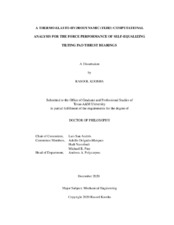| dc.description.abstract | A self-equalizing tilting pad thrust bearing (TPTB) improves operation reliability by adjusting its pads to accommodate thrust collar tilt, and hence removing a source of frequent wearing. Although recent literature states the need, predictive models for self-equalizing TPTBs are not available due to the complexity of their geometry. To date published analyses limit to a few highly simplified analytical models. Nonetheless, a bearing manufacturer recently presented a complicated finite element model but excluded the fluid film analyses. The dissertation builds a thermo-elasto-hydrodynamic (TEHD) analysis tool and couples with a model for the pads leveling mechanism to deliver load performance predictions for self-equalizing TPTBs.
The dissertation presents predictions for an example self-equalizing TPTB operating with a 0.01 thrust collar static misalignment and which equals to 75% of the nominal minimum film thickness when the bearing operates under 2 MPa/pad load and with a perfectly aligned thrust collar. The bearing has six pads with 63 mm in inner diameter (ID) and 126 mm in outer diameter (OD), operates at 4krpm (maximum surface speed = 26 m/s) and under a specific load/pad ranging from 0.5 to 3.5 MPa. Compared to a regular (non-equalizing) TPTB, a self-equalizing TPTB operates with up to 50% larger minimum film thickness and a roughly 1/2 of peak elastic deformation. Friction forces acting at the contact points of the leveling plates show a significant effect on the performance of the pad leveling system as they reduce the film clearance and increase a pad peak pressure. Predictions show a significantly large peak pressure at the contact points of the leveling plates (> 0.9 GPa) when the bearings operate under a 3 MPa/pad specific load. The present work thus shows the importance of performing a comprehensive multiple-pad analysis to accurately evaluate the performance of self-equalizing TPTBs hence assuring their safe operation.
This dissertation further implements a flow starvation model into the TEHD computational analysis tool to deliver load performance predictions for TPTB operating with reduced flow rate. The work builds a model for the groove flow thermal mixing that determines the temperature of the lubricant entering a thrust pad for bearings operating with either reduced or over-flooded flow conditions. Unlike the hot oil carry-over model, the present model accounts for the churning oil in bearings with end-seals configuration. Under a starved flow condition, the analysis iteratively reduces the effective arc length of a wetted pad until matching the available flow.
The analysis considers an example TPTB with ID= 122 mm and OD=267 mm, 38° pad arc length, operating at 4 krpm and 10 krpm (maximum surface speed ROΩ = 54-135 m/s), and under a specific load per pad from 0.7 MPa to 3.4 MPa. The bearing is supplied with 25% to 150% of the predicted nominal flow rate as well as with a flow rate recommended in the literature (~170% to 420% nominal).
A supply flow rate above the nominal rate, increases the bearing drag torque but has little effect on the pad peak temperature rise or the pad minimum film thickness. A reduced flow, below the nominal rate, produces areas denuded of oil at both the pad leading edge and trailing edge, and thus the pad minimum film thickness substantially decreases while the film peak pressure largely increases. At 4 krpm and under a heavy load of 3 MPa/pad, the pad subsurface temperature rise almost doubles with a 30% nominal flow and exceeds the Babbitt critical temperature = 130°C. Also, compared to a flooded flow bearing, a starved flow bearing shows a larger axial stiffness coefficient but a much lesser axial damping coefficient. Despite a significant increase in the bearing drag torque, the recommended flow rate does not lead to either a notable increase in the minimum film thickness nor to a decrease in the maximum pad temperature rise.
At a high rotor speed of 10 krpm, the example TPTB with a flooded configuration (with end-seals) operates with up to 11 μm lesser minimum film thickness, a 10 °C larger pad maximum temperature rise, and a 11% larger bearing axial stiffness compared to those in an identical bearing but with evacuated configuration (without end-seals). The bearing ends configuration, however, shows marginal influence on the bearing performance at a low speed of 4 krpm.
In sum, the dissertation introduces simple and effective models to deliver load performance predictions for self-equalizing TPTBs and TPTBs supplied with reduced flow rates. In particular, the dissertation advances the state-of-the-art by pioneering a computational analysis model for self-equalizing TPTBs and produces unique knowledge on their load performance characteristics. | en |


